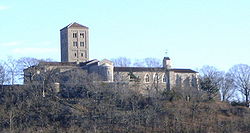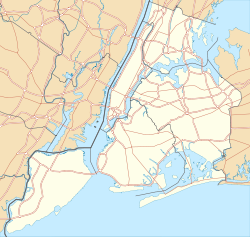- The Cloisters
-
For other uses, see The Cloisters (disambiguation).
Coordinates: 40°51′53″N 73°55′55″W / 40.86484°N 73.931905°W
The Cloisters 
The Cloisters as seen from the Hudson River.Established May 10, 1938 Location Fort Tryon Park, Manhattan, New York City Type Medieval Art Collection size 1,854 Public transit access Bus: M4 to museum's entrance
Subway: 190th St
Website http://www.metmuseum.org/cloisters/ The Cloisters is a museum located in Fort Tryon Park, New York City. The building, which is a branch of the Metropolitan Museum of Art, was reconstructed in the 1930s from the architectural elements of several European medieval abbeys. It is used to exhibit art and architecture from Medieval Europe.
The Cloisters, which is near the northern tip of Manhattan island on a hill overlooking the Hudson River, incorporates parts from five French cloistered abbeys. Buildings at Saint-Michel-de-Cuxa, Saint-Guilhem-le-Désert, Bonnefont-en-Comminges, Trie-en-Bigorre, and Froville were all disassembled brick-by-brick before being shipped to New York. Between 1934 and 1938, the features were reassembled in Fort Tryon Park.
The area around The Cloisters was landscaped with gardens planted according to horticultural information obtained from medieval manuscripts and artifacts, and the structure includes multiple medieval-style cloistered herb gardens.
Contents
History
 French Late Gothic Virgin and Child, 14th century, from Cernay-lès-Reims.
French Late Gothic Virgin and Child, 14th century, from Cernay-lès-Reims.
The museum and adjacent park, which incorporate four acres (16,000 m²), were created through an endowment grant by John D. Rockefeller, Jr., who also donated the majority of his medieval art collection to the project. Much of this art collection came from George Grey Barnard, an American sculptor and collector of medieval art, who had already established a medieval-art museum near his home in Fort Washington.
After Rockefeller purchased Barnard's entire collection, he gave the collection to the Metropolitan Museum of Art. Barnard's collection, combined with a number of pieces from Rockefeller's own collection (including the Unicorn tapestries), became the centerpiece for The Cloisters. Rockefeller subsequently purchased more than 65 acres (260,000 m2) of land north of Barnard's museum with the intention of converting it into a public park and site for the new museum.[1] Rockefeller also bought and donated several hundred acres of the New Jersey Palisades to the State of New Jersey on the other side of the Hudson River to preserve the view for the museum.
The museum buildings were designed by Charles Collens the architect of New York City's Riverside Church who reconstructed the cloister elements salvaged from Europe by simplifying and merging the various medieval styles. In 1988, the Treasury gallery within The Cloisters, containing objects used for liturgical celebrations, personal devotions, and secular uses, was renovated. Other galleries were refurbished in 1999.
Collection
The Cloisters collection contains approximately five thousand European medieval works of art, with a particular emphasis on pieces dating from the 12th through the 15th centuries. Notable works of architecture include the Cuxa cloister, with an adjacent Chapter House; and the Fuentidueña Apse from a chapel in the province of Segovia (Castilla y León, Spain).
Among the works of art are seven Flemish tapestries depicting The Hunt of the Unicorn,[2] Robert Campin's Mérode Altarpiece,[3] and the Romanesque altar cross known as the Cloisters Cross or Bury St. Edmunds Cross, which was acquired under the curatorship of Thomas Hoving.
The Cloisters also holds many medieval manuscripts and illuminated books, including the Limbourg brothers' Les Belles Heures du Duc de Berry and Jean Pucelle's book of hours for Jeanne d'Evreux.
Gallery
-
During the winter, potted plants—such as these crocuses—are brought indoors.
See also
References
- ^ Metropolitan Museum of Art website article on the Cloisters
- ^ "Tapestry in the Renaissance: Art and Magnificence". The Metropolitan Museum of Art. http://www.metmuseum.org/Special/Tapestry/5.r.htm. Retrieved 2008-01-09.
- ^ for example by Campbell in: National Gallery Catalogues (new series): The Fifteenth Century Netherlandish Paintings, p. 72, Lorne Campbell, 1998, ISBN 185709171X and his 1974 Burlington article JSTOR specifically dealing with the authorship of the work
Literature
- Peter Barnet and Nancy Wu, The Cloisters. Medieval Art and Architecture. Metropolitan Museum of Art, Yale University Press. New York: 2006.
- Thomas Hoving. King of the Confessors. Simon & Schuster. New York, New York: 1981.
- Thomas Hoving, King of the Confessors: A New Appraisal. cybereditions.com. Christchurch, New Zealand: 2001.
- James J. Rorimer, The Cloisters. The Building and the Collection of Mediaeval Art in Fort Tryon Park, 11th edition, New York 1951.
External links
- Guide to The Cloisters—About.com
- Planning a Visit to The Cloisters
- The Cloisters
- Hours of Jeanne d'Evreux
- Merode Altarpiece
Coordinates: 40°51′53″N 73°55′55″W / 40.86484°N 73.931905°W
Categories:- Metropolitan Museum of Art
- European medieval architecture in the United States
- Institutions founded by the Rockefeller family
- Washington Heights, Manhattan
- Buildings and structures on the National Register of Historic Places in Manhattan
- Relocated buildings and structures in the United States
- Museums in Manhattan
- Art museums in New York
- Medieval art
Wikimedia Foundation. 2010.







